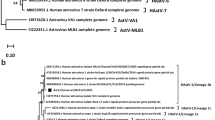Abstract
The species Enterovirus B includes diverse serotypes that can cause a wide spectrum of human diseases, such as aseptic encephalitis, myocarditis, and paralysis. In this study, a 4-year-old child was diagnosed with viral encephalitis, but the causative agent could not be identified using routine immunological tests. Using metagenomic RNA sequencing, a novel strain of enterovirus B, strain PC06, was identified, and its genome sequence was determined by RT-PCR and Sanger sequencing. The viral genome sequence was most similar to that of echovirus E18 strain E18-HeB15-54498/HeB/CHN/2015 (GenBank accession MG720261), with 87.73% nucleotide sequence identity, while the viral proteins shared 96.98% amino acid sequence identity with those of E18 strain Jena/AN1365/10 (GenBank accession no. KX139452). Phylogenetic analysis based on the VP1 and 3D genes revealed discrepant placement of PC06 in the two trees. In the 3D tree, PC06 formed a separate branch together with other recombinant E18 strains. Further recombination tests revealed that PC06 had possibly undergone recombination at a site between the structural and non-structural regions during its evolutionary history. Based on the analysis of VP1 phylogeny and using online genotyping tools, this potential recombinant is tentatively considered a strain of echovirus 18. This information might contribute to the diagnosis and prevention of related diseases.


Similar content being viewed by others
References
Tapparel C, Siegrist F, Petty TJ, Kaiser L (2013) Picornavirus and enterovirus diversity with associated human diseases. Infect Genet Evol 14:282–293
Chen B-S, Lee H-C, Lee K-M, Gong Y-N, Shih S-R (2020) Enterovirus and encephalitis. Front Microbiol 11:261
Huang H-I, Shih S-R (2015) Neurotropic enterovirus infections in the central nervous system. Viruses 7:6051–6066
Lindberg AM, Andersson P, Savolainen C, Mulders MN, Hovi T (2003) Evolution of the genome of Human enterovirus B: incongruence between phylogenies of the VP1 and 3CD regions indicates frequent recombination within the species. J Gen Virol 84:1223–1235
Oberste MS, Maher K, Pallansch MA (2004) Evidence for frequent recombination within species human enterovirus B based on complete genomic sequences of all thirty-seven serotypes. J Virol 78:855–867
Kroneman A, Vennema H, Deforche K, Avoort H, Peñaranda S, Oberste M, Vinjé J, Koopmans M (2011) An automated genotyping tool for enteroviruses and noroviruses. J Clin Virol 51:121–125
Lukashev AN, Lashkevich VA, Ivanova OE, Koroleva GA, Hinkkanen AE, Ilonen J (2005) Recombination in circulating Human enterovirus B: independent evolution of structural and non-structural genome regions. J Gen Virol 86:3281–3290
Gray LD, Fedorko D (1992) Laboratory diagnosis of bacterial meningitis. Clin Microbiol Rev 5:130–145
Bolger AM, Lohse M, Usadel B (2014) Trimmomatic: a flexible trimmer for Illumina sequence data. Bioinformatics 30:2114–2120
Li D, Liu C-M, Luo R, Sadakane K, Lam T-W (2015) MEGAHIT: an ultra-fast single-node solution for large and complex metagenomics assembly via succinct de Bruijn graph. Bioinformatics 31:1674–1676
Buchfink B, Xie C, Huson DH (2015) Fast and sensitive protein alignment using DIAMOND. Nat Methods 12:59–60
Sun G, Yi M, Tian H, Shao C, Yang S, Han J, Wang X, Wang Y, Shen Q, Wang H (2014) A novel human enterovirus recombinant from a child with diarrhea. Adv Virol 159:333–337
Kumar S, Stecher G, Tamura K (2016) MEGA7: molecular evolutionary genetics analysis version 7.0 for bigger datasets. Mol Biol Evol 33:1870–1874
Guindon S, Dufayard J-F, Lefort V, Anisimova M, Hordijk W, Gascuel O (2010) New algorithms and methods to estimate maximum-likelihood phylogenies: assessing the performance of PhyML 3.0. Syst Biol 59:307–321
Martin DP, Murrell B, Golden M, Khoosal A, Muhire B (2015) RDP4: Detection and analysis of recombination patterns in virus genomes. Virus Evol 2015:1
Lole KS, Bollinger RC, Paranjape RS, Gadkari D, Kulkarni SS, Novak NG, Ingersoll R, Sheppard HW, Ray SC (1999) Full-length human immunodeficiency virus type 1 genomes from subtype C-infected seroconverters in India, with evidence of intersubtype recombination. J Virol 73:152–160
Tyler KL (2018) Acute viral encephalitis. N Engl J Med 379:557–566
Singh TD, Fugate JE, Rabinstein AA (2015) The spectrum of acute encephalitis: causes, management, and predictors of outcome. Neurology 84:359–366
Kennedy PG, Quan P-L, Lipkin WI (2017) Viral encephalitis of unknown cause: current perspective and recent advances. Viruses 9:138
Miao Z, Yan J, Sun Y, Chen Y, Gong L, Ge Q, Shi W, Pan J, Mao H, Zhang Y (2020) Etiology and molecular-epidemiological characteristics of viral meningo-encephalitis in Zhejiang province, 2002–2018. Zhonghua Liuxingbingxue Zazhi 41:562
Chen X, Li J, Guo J, Xu W, Sun S, Xie Z (2017) An outbreak of echovirus 18 encephalitis/meningitis in children in Hebei Province, China, 2015. Emerg Microbes Infect 6:1–3
Li W, Qiong Z, Xiao-Ting S, Yu-Jie L, Jian-Hua M, Qiang S, Shi-Qiang S (2016) Molecular epidemiological study of enteroviruses associated with encephalitis in children from Hangzhou, China. Medicine 95:e4870
Chen X, Ji T, Guo J, Wang W, Xu W, Xie Z (2019) Molecular epidemiology of echovirus 18 circulating in mainland China from 2015 to 2016. Virol Sin 34:50–58
Lu J, Kang M, Zeng H, Zhong Y, Fang L, Zheng X, Liu L, Yi L, Lin H, Peng J (2020) Tracking echovirus eleven outbreaks in Guangdong, China: a metatranscriptomic, phylogenetic, and epidemiological study. Virus Evol 6:veaa029
Acknowledgements
This work was financially supported by the Medical Innovation Team of Jiangsu Province (Grant no. CXTDB2017016) and Top Talent Support Program for young and middle-aged people of Wuxi Health (Grant no. HB2020087).
Author information
Authors and Affiliations
Corresponding authors
Ethics declarations
Conflict of interest
The authors declare no conflicts of interest.
Ethical approval
This study was approved by the Ethics Committee of the Affiliated Wuxi Children's Hospital of Nanjing Medical University (number: WXCH2019-03-001).
Additional information
Handling Editor: Zhenhai Chen.
Publisher's Note
Springer Nature remains neutral with regard to jurisdictional claims in published maps and institutional affiliations.
Supplementary Information
Below is the link to the electronic supplementary material.
Rights and permissions
About this article
Cite this article
Kang, Y., Hua, Y., Sun, M. et al. A potential new recombinant echovirus 18 strain detected in a 4-year-old child with encephalitis in China in 2019. Arch Virol 166, 1231–1236 (2021). https://doi.org/10.1007/s00705-020-04907-w
Received:
Accepted:
Published:
Issue Date:
DOI: https://doi.org/10.1007/s00705-020-04907-w



